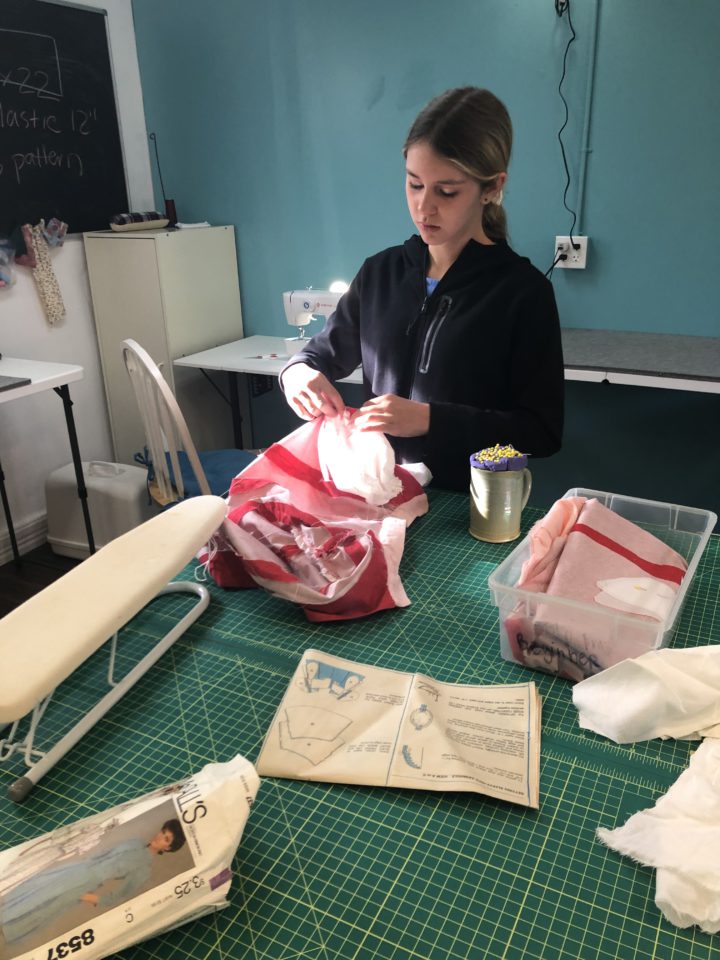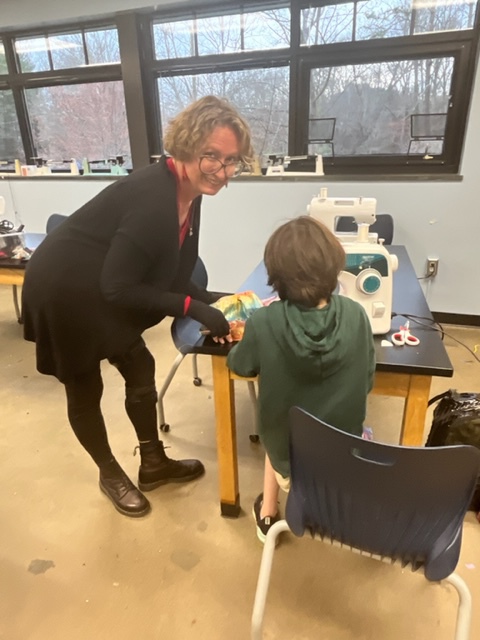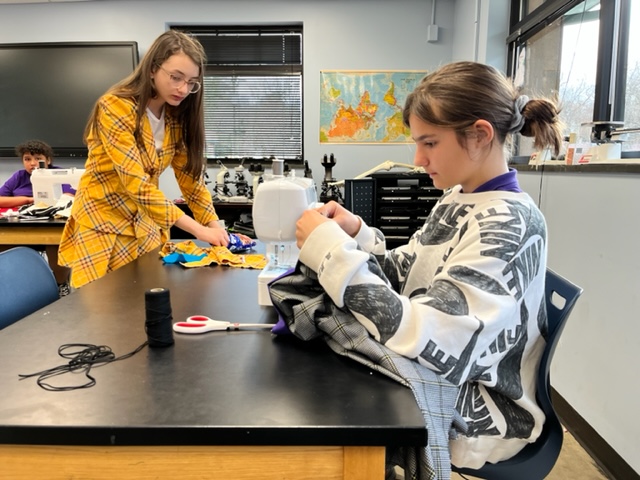Olivia Slosiarek was struggling to sew a collar on the bodice of a dress. “Why did you choose a supercomplicated dress?” Stina Andersen asked her young student with a smile.
Slosiarek’s answer was thoughtful: She explained that something about the below-the-knee dress, depicted on a 1980s McCall’s pattern she found in Andersen’s classroom, appealed to her.
Andersen understood. “You want your own unique style,” she said. Her young student agreed. In this case, the style unique to an 11-year-old would be familiar to boomer moms, but Andersen had seen that before. “Fashion is just a revolution — it goes ’round and ’round, right?”
It was a Tuesday afternoon in March, and Andersen was leading the final week of an eight-week beginner course at ARTeries, her studio and boutique. A former art instructor, she began teaching sewing classes in Asheville in 2007 where adults and children learn how to make their own clothing and “upcycle” existing clothes.
“One of the biggest takeaways that they get is how much time it takes to make things and how much effort goes into it,” Andersen says.
All the fabric at ARTeries has been donated, thrifted or reused from Andersen’s own collection, she says. People are inspired to give their fabrics “especially if they have a big collection,” Andersen explains. “I had a woman who couldn’t seem to sew anymore, so her daughter brought her old embroidery machine and all of these fabrics.”
Andersen teaches her students to measure correctly and “cut smart” to reduce textile waste. “Let’s respect these materials because there’s value in all of it,” she explains. “Even if it’s free to you, [the fabric] was woven.”

Waste not
Jen Hampton is on a similar mission at Hanger Hall School. She was hired by students’ parents in 2021 to teach a seven-week, after-school sewing club four times a year.
Several students “love to express themselves with their clothing,” she says. “They love the feeling of people saying, ‘I love that’ and being able to say, ‘Thanks, I made it.’”
The sewing club is also an opportunity for Hampton to educate them about repurposing and reusing textile resources.
“I’ve talked to the girls about how wasteful fast fashion is,” Hampton says. “It’s very wasteful and just adds to the piles of garbage eventually.” The U.S. Environmental Protection Agency estimates that landfills received 11.3 million tons of textiles disposed into municipal solid waste; only 2.5 tons were recycled that same year.
Fabric is mostly donated by students’ parents or by Hampton’s acquaintances; she also scored four large bins of fabric for free following the estate sale for a fiber artist in West Asheville.
Hampton saves hardware, like buttons, from clothes that she thrifts from Goodwill. She sometimes uses that hardware or materials to create her own designs. Her students call that process “thrift flipping,” Hampton explains — akin to “house flipping” — instead of the more common term “upcycling.”
Twice is nice
Andersen also “harvests” buttons, hems and collars from garments — some of which are donated to her and others that she found at thrift shops. She then categorizes and stores them for future use in her studio. She also has an entire bookcase full of patterns, many of which she’s bought in bulk purchases on eBay.
Basic and medium-level sewing skills compose most of Andersen’s classes. However, she says demand for mending and alteration skills has been high since the start of the COVID-19 pandemic. “I definitely noticed a significant rise in people’s interest in learning to sew and learning to make their own stuff or fixing stuff,” Andersen says.
A fashion designer as well as a sewing instructor, Andersen sells her own upcycled designs in her studio. “There’s so many things out there that can be reinvented — that’s where my creative inspiration comes from,” she explains. “What I decide to make, a lot of the time it is determined by what materials come in.”
Andersen develops “what I call a ‘recipe for refashion’” for products; with a recipe in hand, she can repurpose similar items into new designs over and over again.
‘Sense of empowerment’
Previous attendees of Hampton’s sewing club made a lot of “thrift flips,” she says. The current attendees are working on a mix of designs from both donated fabric and fabric they purchased themselves.
Regan Sacca, 11, sewed four vests — including one for a Halloween costume based on a “Monster High” character — and a corset. She showed Xpress her current project, a pair of shorts constructed of pink and multicolored fabric.

Aubrey McCormick, 12, showed off a ruffled strawberry-patterned dress that she sewed. “The ruffles were really hard to make,” she says, explaining that she created them using hand and machine sewing. (The students share six Brother sewing machines; two that were gifted and four that were purchased by Hanger Hall.) “I used to try and do a lot of hand sewing but that is not nearly as efficient,” McCormick continued. “You can’t really make the bulk of articles of clothing by hand.”
Hampton believes these self-sufficiency skills give her students “a sense of empowerment.” Learning “to make anything with your own hands teaches you self-reliance — ‘I have the skills to make whatever it is that I need,’” she says.
Julianne Stanley, 13, is one such student. She adores the movie Clueless and admired the Dolce & Gabbana yellow plaid matching skirt and jacket worn in the movie by character Cher Horowitz, played by Alicia Silverstone. So she sewed a replica of the outfit this year.
“It’s so easy,” Stanley explains. “If I can’t find something in a store, I can just make it.”




Before you comment
The comments section is here to provide a platform for civil dialogue on the issues we face together as a local community. Xpress is committed to offering this platform for all voices, but when the tone of the discussion gets nasty or strays off topic, we believe many people choose not to participate. Xpress editors are determined to moderate comments to ensure a constructive interchange is maintained. All comments judged not to be in keeping with the spirit of civil discourse will be removed and repeat violators will be banned. See here for our terms of service. Thank you for being part of this effort to promote respectful discussion.